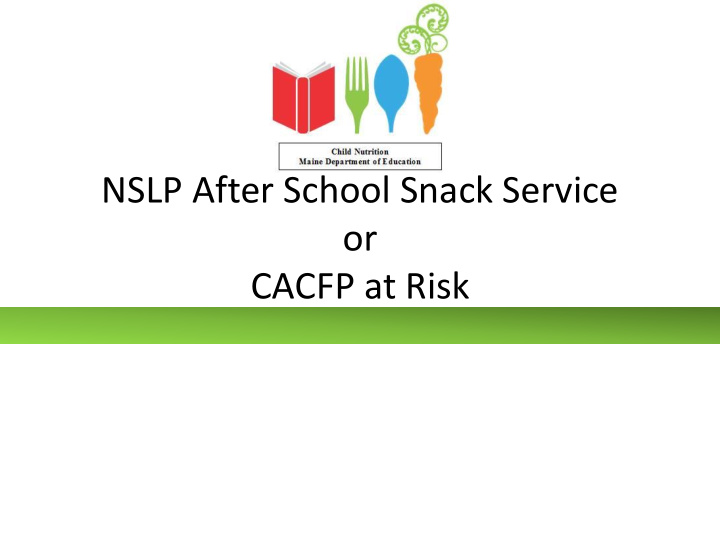



NSLP After School Snack Service or CACFP at Risk
Legislative Updates • LD 577 An Act to Increase Access to Nutritious Foods in Schools by Implementing an After- School Food Program for At-Risk Students
Which are you? CACFP At Risk NSLP/ After School Snack Service • • Public School Public School • Under 50% • Over 50% • Sponsor or operate an approved afterschool care • Sponsor or operate an program approved afterschool care • Serve a 2 component snack program • Claim by free, reduced, and paid • Serve a 5 component meal • Claim everyone free • Attend a CACFP training *The district may opt out of providing an At Risk program
How It Works Children participating in an approved afterschool care program age 18 and under, and participating children who turn 19 during the school year, are eligible to receive reimbursable snacks through the NSLP
Requirements for ASSS • SFA must participate in the NSLP lunch component • Site must sponsor or operate an approved afterschool care program
Types of Afterschool Care Programs That Are Eligible The afterschool care program must: • Provide care for children; • Have organized, scheduled education or enrichment activities in a supervised environment.
Types of Afterschool Care Programs That Are Eligible Examples: • Homework assistance • Tutoring • Supervised “drop - in” athletic programs • Extended day programs • Drama activities, and • Arts and crafts programs. Organized interscholastic programs or community-level competitive sports are not eligible to participate
Meal Pattern ASSS Afterschool Snack must include full servings of two of any of the following four food components: • Fluid Milk. • Meat or meat alternate. • Vegetable/ fruit, or 100% juice. • Whole-grain or enriched bread (or an equivalent serving of a bread product) or a serving of cooked whole-grain or enriched pasta or noodle products. – Juice must not be served when fluid milk is served as the only other component
Meal Pattern Milk Ages 1‐2 Ages 3‐5 Ages 6‐18* Milk must be fat‐free or low fat (1%) ½ Cup ½ Cup 1 Cup unflavored or flavored.
Meal Pattern Meat/Meat Alternate Ages 1-2 Ages 3-5 Ages 6-18 Refer to the USDA Food Buying ½ oz eq ½ oz eq 1 oz eq Guide for Child Nutrition Programs for crediting information.
Meal Pattern Grains Ages 1-2 Ages 3-5 Ages 6-18 Whole-grain or enriched bread (or an ½ oz eq ½ oz eq 1 oz eq equivalent serving of a bread product) or a serving of cooked whole-grain or enriched pasta or noodle products.
Meal Pattern Fruits and Vegetables Ages 1-2 Ages 3-5 Ages 6-18 Vegetable or fruit, or full- 1/2 Cup 1/2 Cup 3/4 Cup strength vegetable or fruit juice
OvS is not an option in ASSP If a 4oz apple sauce was your only fruit/vegetable component- you would have to serve 2 to make a full serving size.
Reimbursement NSLP/ASSS Programs receive the free, reduced-price, or paid rate depending on each child’s family income. • Free .94 • Reduced .47 • Paid .08
Sites operating under NSLP ASSS Must: • Document participating children’s based on individual eligibility status. The SFA will only be reimbursed for students with documentation of eligibility status and receive the paid reimbursement • If an approved free or reduced price application or direct certification match is not on file for a child, the SFA will claim the child as paid.
Records Must be Maintained • Sites must record and report the number of snacks served each day by category of reimbursement (i.e., free, reduced price, or paid). • Complete mandatory site monitoring
CACFP At Risk School Districts, in areas where at least 50 percent of children are eligible for free or reduced priced meals AND have an open afterschool enrichment program can participate in the CACFP At Risk program and serve a 5 component supper after school at a higher reimbursement rate. On vacation days, weekends, and holidays (excluding summer break) schools participating in CACFP can serve up to one meal and one snack per day.
CACFP Training To implement an At Risk Program you will be required to attend the At-Risk 101 Webinar. Date TBD, please keep your eye on the Child Nutrition List serve. For questions regarding At-Risk Afterschool, please contact Alissa Mank at Alissa.m.mank@maine.gov
At Risk Legislation • Sec. 1. 20-A MRSA §6602, sub-§1, ¶D is enacted to read: • D. A school administrative unit shall participate in the federal child and adult care food program established in 42 United States Code, Section 1766 as required under this paragraph. The commissioner shall assist school administrative units subject to the requirements of this paragraph in developing a plan to participate in the federal child and adult care food program to serve at-risk students who attend after-school programming and in obtaining federal, state and private funds to pay for this program. Beginning with the 2019-2020 school year, a school administrative unit with at least one public school in which at least 50% of students qualified for a free or reduced-price lunch during the preceding school year shall participate in the federal child and adult care food program in accordance with 42 United States Code, Section 1766 during the school year, subject to the provisions of this paragraph. Notwithstanding other provisions of this paragraph, a school administrative unit that is required to operate a federal child and adult care food program may choose not to operate such a program if it determines by a vote of the governing body of the school administrative unit after notice and a public hearing that operating such a program would be financially or logistically impracticable.
Questions ?
Recommend
More recommend